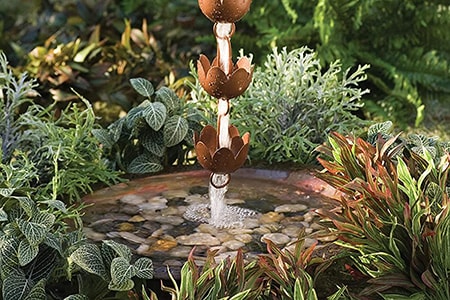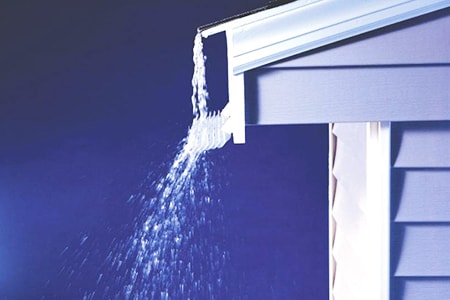8 Gutter Alternatives That Work as Well and Look Better
Author: Omar Alonso | Editor: Omar Alonso
Review & Research: Jen Worst & Chris Miller

Gutter alternatives are a great choice when you either don't have any gutters or are looking to replace your existing ones. You don't have to follow the typical pattern everyone uses.
Most houses come with traditional gutters—these contraptions have seemingly existed forever, faithfully collecting rainwater and deflecting it from buildings, ensuring that none of that deadly water seeps in, wrecking the home’s foundation and walls.
However, gutters can sometimes be as high maintenance as a Kardashian—they can easily leak, rot, and get clogged, making maintenance quite a pain where it hurts the most.
Additionally, water hitting the ground from these gutters can damage your walls as they splash, or find their way into your crawl spaces and basements. And let’s not even talk about the clogging again.
Traditional types of gutters may have their pros but they come with more than their fair share of problems; clogging and damage apart, they’re also not very good looking and can take away a lot from your house’s look.
8 Gutter Alternatives
If you want to avoid the headache of having to clean your gutter 4 times a year and not have to deal with issues like ice dams and bad aesthetics, or you just want to get with the times and try something new yet effective, here’s a list of gutter alternatives that you can consider. A house can't go for too long without gutters, so definitely get something in place.
Rain Chains

Kusari Doi, as the Japanese call them, are not only effective but extremely attractive. The Japanese have been using these devices for centuries now—rain chains are obviously doing their job right if they’ve managed to stick around that long.
A great (and better looking) substitute for the traditional gutter-downspout system, rain chains work by collecting rainwater from the roof and directing it to underground reservoirs, generally barrels.
This is possible thanks to the many beautiful cups strung in a line that not only transport the water from the top to the bottom but also reduce the force of the flowing water.
Rain chains are available in a range of different designs and are probably the best combination of looks and usefulness when it comes to gutter alternatives.
You can use them with an ordinary rain gutter by replacing the downspout, too, which only adds to their considerable list of pros.
You can opt for a single chain, the cup-system chain, or multiple chains and have the collection unit placed either underground or above ground. These chains not only get the job done but also bring a beautiful Zen vibe to the space.
Drip Edges

Drip edges are metal-strip attachments that you can attach to the edge of your roof, acting as an additional hurdle that reduces the force and speed of the falling water.
Additionally, they keep the water from flowing close to your walls. Drip edges are installed between the shingle and roof deck; this prevents water from seeping into the wood that’s under the shingle.
Therefore, drip edges not only protect the foundation but also ensure that water doesn’t splash on the side and ruin your walls, staining them and introducing mold. The Gutter Edge is one of the best choices out there.
You can also use a drip edge with a rain gutter to enhance the efficiency of the rain-water deflection. That's the main point. They aren't pure gutter alternatives, but more of enhancers.
Drip Path

Drip paths are paved pathways that are placed exactly under the edge of your roof so that any rainwater falling off your roof is trapped by these paths.
Drip paths are generally constructed using bricks or blocks that are placed in the soil, thereby protecting the soil from getting eroded by the water flowing from the roof.
The hard surface prevents the water from seeping into the soil; additionally, the blocks or bricks are placed at an angle so that the water is deflected away from the building.
Using a concrete apron with the drip, set around 6 inches from the foundation, will also help drain away any rainwater efficiently, especially in combination with the sloping stones. Concrete alternatives like grasscrete that allows grass to grow in drainage zones works too.
Alternately, you could also fashion a path with large stones or pebbles all around your house, but doing so will require setting up an underground drainage system that water can be channeled into.
Rain Dispersal Systems

Rain dispersal systems work by dividing the flowing rainwater into smaller rivulets or even drops, thereby reducing their force and impact.
Though your local home development or hardware store may stock several readily available rain dispersal systems, the most popular system is the Rainhandler, a fittingly-named system that uses an angled-louver system to split the rainwater into smaller streams and direct them into a band (generally, 2 to 3 feet).
With a Rainhandler, your cleaning worries are also reduced—you don’t have to deal with continuously cleaning up your clogged gutters or breaking down those ice dams before they break your gutter.
These patented brainchildren of an MIT-graduate aeronautical engineer can also be installed without the need for any professional help and come with a satisfaction guarantee. To further sweeten the deal, they self-clean, with a smart design that blows away debris, dirt and leaves.
Another popular rain dispersal system is the Rain Breakerz; this efficient system does an impressive job of splitting up each drop of water into as many as 19 smaller droplets!
Grading

If you don’t want a gutter and are still in the process of building your house, get the grading right.
Houses should generally be built at an elevation (meaning above normal ground level) and the difference in height should be, and generally is, made up using a smooth, efficient slope.
This keeps water flowing down and away from whatever types of house foundations you have, preventing it from accumulating when it finds it way from your roof to the ground and into the soil.
Ensure that the slope itself doesn’t have any spots where water can percolate and stagnate.
French Drain / Ground Gutters

Ground gutters are perfect for those looking for non-conspicuous gutter alternatives; these gutters protect the foundation and walls of your house and with minimal effort.
All you need to do is dig a trench (in the shape of a V) at the drip line, or the spot where the water falling from your roof hits the ground.
The trench has to be lined with a waterproof lining and once a perforated pipe is placed at the bottom, the trench is filled with pebbles or gravel.
Ground gutters are also called French drains or in-ground gutters and allow users to lay a network of pipes all around the house. These can also just be rock drainage ditches you build, too.
Ensure that the trench is sloping away from the house, so that water doesn’t stagnate. Any rainwater falling from the roof hits the trench and travels via the pipe to reach the final destination—an underwater drain.
The best part is that ground gutters don’t need to be left exposed—you can even grow plants over them.
Additionally, apart from winning big in the aesthetics area, it also scores major points in the maintenance department—maintenance is almost zero with this type of gutter. We do have a list of french drain alternatives if you want to explore the whole concept more thoroughly.
You’ll only need to check the outlet very, very occasionally to ensure that drainage is free and maybe clear the leaves from the area once Autumn makes an entrance.
Box Gutters

Also known as hidden gutters, or built-in gutters, box gutters are a type of rain gutter that can be used entirely on their own.
Those looking for a more subtle method of drainage than obvious rain gutters will love these gutter alternatives, with their valley-like troughs that sit at roof edges to direct rainwater away.
Box gutters are very inconspicuous and don’t deflect any attention from the architectural beauty of the building itself. Unlike ordinary gutters, they are not cylindrical, which means that you can bid adieu to any clogging issues and therefore, maintenance headaches.
However, if they’re not easily seen by your neighbor, that also means they may not be easily seen by you, too, which further means that any issues such as the rare blockage or corrosion may hit high levels before you realize that something’s up with your gutter.
Copper Gutters

Copper gutters may be regular gutters, but they’re definitely much better looking than traditional gutters.
Copper gutters come with several advantages, such as low maintenance, a rust-proof make and amazing durability—a copper gutter, with the right installation, could last you anywhere between 30 and 100 years!
Installing any of these alternatives that attach to the house are going to require one of the many types of ladders. I just want to stress that you take extra precaution and keep your awareness about you so there's no accidents.
Gutter Alternatives are Equally Effective
Much as we would like it to be otherwise, many experts claim that gutters are a necessity; you shouldn’t be scrimping on one unless you live in an area that doesn’t receive much rainfall. The only bonus is that you don't have to learn how to get rid of a bird's nest in your gutter.
If you do settle for a gutter, ensure that it’s well fitted so that your house is protected at all costs; getting a gutter that ends up damaging your house is quite obviously counterproductive.
If you’re looking for a gutter alternative only to do away with the clogging, buy a gutter lid to keep out the debris, instead of replacing the entire system.
If the aesthetic value is the issue, get a gutter in a more attractive design and material, such as a copper gutter or even better, a hidden gutter! You can also opt for sectional gutters or even better, seamless gutters that come pre-assembled with lesser joints resulting in lesser leakage.
In the mean time, you may find some use out of these sandbag alternatives to keep this rain water from making its way into your garage, basement, and foundation.
Ultimately, if you do want to replace your gutter, our list of gutter alternatives should have you covered!



